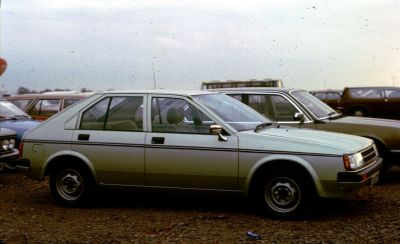 1977 Volkswagen Derby (86) Dimensions, Size & Specs
1977 Volkswagen Derby (86) Dimensions, Size & SpecsMeasurements of the 1977 Volkswagen Derby, engineered for optimal performance and comfort
| Dimensions | |
|---|---|
| Length: | 3914 mm154.1 in12.8 ft |
| Width: | 1557 mm61.3 in5.1 ft |
| Height: | 1351 mm53.2 in4.4 ft |
| Ground Clearance: | 97 mm3.8 in0.3 ft |
| Trunk Capacity: | 515 liter18.2 cu ft |
| Weight Specifications | |
| Curb Weight: | 700 kg1543 lbs |
| Maximal permitted Weight: | 1130 kg2491 lbs |
| Tire Specifications | |
| Rims Size: | 13-inch rims:
|
The Volkswagen Derby (86), produced between 1977 and 1981, is a compact sedan that reflects the practical and efficient design ethos of late 1970s Volkswagen vehicles. Measuring 3914 mm (154 inches) in length, 1557 mm (61.3 inches) in width, and standing 1351 mm (53.2 inches) tall, the Derby offers a compact yet comfortable footprint suitable for urban and suburban driving. Weighing in at a curb weight of 700 kg (1543 lbs) and a maximum permissible weight of 1130 kg (2491 lbs), the Derby emphasizes lightweight construction, contributing to its nimble handling and fuel efficiency. This sedan features a generous luggage capacity of 515 liters (18.2 cubic feet), which was quite spacious for a compact car of its era, making it practical for everyday use, especially for small families or commuters. The ride height or ground clearance of the Derby is measured at 97 mm (3.8 inches), which balances aerodynamic efficiency with reasonable clearance for typical road conditions, though it is not designed for off-road use. The vehicle rides on 13-inch rims sized 4.5J x 13, complementing the overall compact dimensions and contributing to its classic, understated stance on the road. Overall, the Volkswagen Derby (86) is a notable example of Volkswagen's strategy in the late 1970s to offer reliable, compact sedans with efficient use of space and balanced technical specifications, making it an appealing choice for drivers seeking a practical and economical vehicle from that period.
Discover the standout features that make the 1977 Volkswagen Derby a leader in its class
Have a question? Please check our knowledgebase first.
The Volkswagen Derby (86) measures 3914 mm (154 inches) in length, 1557 mm (61.3 inches) in width, and 1351 mm (53.2 inches) in height. These compact dimensions make it a typical small sedan from its era, offering a balanced size suitable for urban and suburban driving while maintaining maneuverability. The relatively compact width and height contribute to its classic 1970s sedan silhouette.
The Volkswagen Derby (86) has a curb weight of approximately 700 kg (1543 lbs), which refers to the vehicle's weight without passengers or cargo. Its maximum permissible weight, often called gross vehicle weight rating (GVWR), is about 1130 kg (2491 lbs). This means the car can safely carry passengers and cargo weighing up to 430 kg (948 lbs) in addition to its base weight.
The Volkswagen Derby (86) offers a luggage capacity of 515 liters (18.2 cubic feet), which is quite generous for a compact sedan from the late 1970s. This capacity allows for considerable storage space for luggage, groceries, or other cargo. Compared to similar cars of its era, the Derby's 515-liter trunk is practical and competitive, supporting its design focus on functionality and day-to-day usability.
The ground clearance of the Volkswagen Derby (86) is 97 mm (3.8 inches). This relatively low ride height reflects its sedan design, prioritizing stability and handling on paved roads. While this clearance is suitable for regular city and highway driving, it makes the car less ideal for rough terrains or off-road conditions, providing minimal buffer against road obstacles.
The Volkswagen Derby (86) is equipped with 13-inch rims sized at 4.5J x 13. These modestly sized rims complement the car's compact proportions, contributing to a smooth ride and balanced handling. Such rim sizes were common for small sedans in the late 1970s, balancing tire availability, cost, and comfort.
Yes, the Volkswagen Derby (86) fits comfortably into a standard residential garage. Typical single-car garage dimensions are about 2.4 to 3 meters (7.9 to 9.8 feet) wide and 5 to 6 meters (16.4 to 19.7 feet) long, while the Derby's length is 3.914 meters (12.84 feet) and width 1.557 meters (5.11 feet). Its compact height (1.351 meters or 4.43 feet) further ensures ample clearance. This makes parking and storage practical for most home garages without requiring special accommodations.
The Volkswagen Derby (86), produced from 1977 to 1981, largely maintains similar compact dimensions typical of its class, but minor refinements were made compared to its predecessor. While exact predecessor dimensions vary depending on region, the (86) generation slightly improved in length and luggage capacity, emphasizing practical usability. Overall, the change focused on modest updates rather than radical redesigns, retaining the original’s compact footprint but enhancing interior and trunk space.
When compared with other compact sedans from the late 1970s, the Volkswagen Derby (86) is quite competitive in size and practicality. Its length of 3.914 meters and generous 515-liter trunk space often exceeded similar cars in its class, offering better luggage capacity. The relatively low weight at 700 kg also contributed to nimble performance and fuel efficiency. While not the widest, its dimensions provided a comfortable cabin for a small sedan without compromising manageability, making it a strong contender among compact European sedans of its time.
The Volkswagen Derby (86) is a four-door sedan, a body style popular during its production years (1977-1981) for its practical passenger access and spacious trunk. This body style targeted urban drivers and small families looking for economical yet functional transportation. Its sedan configuration provided a good balance of passenger comfort, cargo space, and ease of driving, making it suitable for both city commutes and light travel.
The Volkswagen Derby (86) was produced between 1977 and 1981. This four-year production period reflects its role as a transitional small sedan in Volkswagen’s lineup, bridging design and engineering improvements of that era. Today, due to its age and limited production years, the Derby is considered a classic car with limited availability on the used market. It holds interest for collectors and enthusiasts interested in vintage European compact cars, but one should expect scarcity and the need for restoration when acquiring.
Discover similar sized cars.

| Production: | 1982-1986 |
|---|---|
| Model Year: | 1982 |
| Length: | 3960 mm155.9 in |
| Width: | 1620 mm63.8 in |
| Height: | 1385 mm54.5 in |
